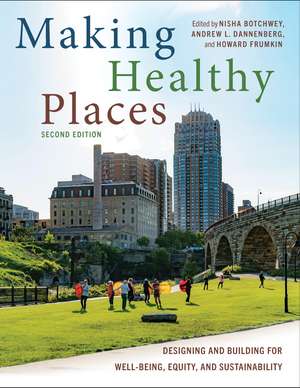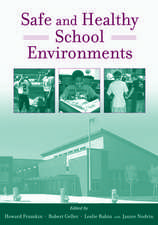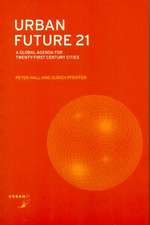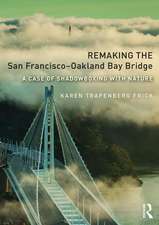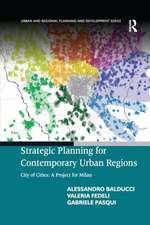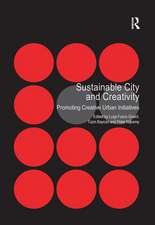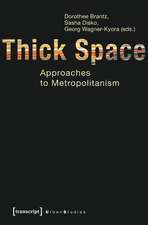Making Healthy Places, Second Edition: Designing and Building for Well-Being, Equity, and Sustainability
Autor Nisha Botchwey, Andrew L. Dannenberg, Howard Frumkinen Limba Engleză Paperback – 12 iul 2022
In Making Healthy Places, Second Edition: Designing and Building for Well-Being, Equity, and Sustainability, planning and public health experts Nisha D. Botchwey, Andrew L. Dannenberg, and Howard Frumkin bring together scholars and practitioners from across the globe in fields ranging from public health, planning, and urban design, to sustainability, social work, and public policy. This updated and expanded edition explains how to design and build places that are beneficial to the physical, mental, and emotional health of humans, while also considering the health of the planet.
This edition expands the treatment of some topics that received less attention a decade ago, such as the relationship of the built environment to equity and health disparities, climate change, resilience, new technology developments, and the evolving impacts of the COVID-19 pandemic.
Drawing on the latest research, Making Healthy Places, Second Edition imparts a wealth of practical information on the role of the built environment in advancing major societal goals, such as health and well-being, equity, sustainability, and resilience.
This update of a classic is a must-read for students and practicing professionals in public health, planning, architecture, civil engineering, transportation, and related fields.
Preț: 361.69 lei
Nou
Puncte Express: 543
Preț estimativ în valută:
69.21€ • 72.44$ • 57.60£
69.21€ • 72.44$ • 57.60£
Carte disponibilă
Livrare economică 10-24 martie
Livrare express 21-27 februarie pentru 62.69 lei
Preluare comenzi: 021 569.72.76
Specificații
ISBN-13: 9781642831573
ISBN-10: 1642831573
Pagini: 552
Ilustrații: 131 photos-figures
Dimensiuni: 216 x 279 x 25 mm
Greutate: 1.08 kg
Ediția:Second Edition
Editura: Island Press
Colecția Island Press
ISBN-10: 1642831573
Pagini: 552
Ilustrații: 131 photos-figures
Dimensiuni: 216 x 279 x 25 mm
Greutate: 1.08 kg
Ediția:Second Edition
Editura: Island Press
Colecția Island Press
Notă biografică
Nisha Botchwey, PhD, MCRP, MPH is the Dean of the Hubert H. Humphrey School of Public Affairs at the University of Minnesota and the Russell M. and Elizabeth M. Bennett Chair in Excellence in Public Affairs. She previously served as Associate Professor in Georgia Tech’s School of City and Regional Planning, adjunct professor of Public Health in Emory University’s Rollins School of Public Health, and Associate Dean of Academic Programs at Georgia Tech Professional Education. She coauthored Health Impact Assessment in the United States and multiple peer reviewed publications.
Andrew L. Dannenberg, MD, MPH, is an Affiliate Professor in the Departments of Environmental and Occupational Health Sciences and Urban Design and Planning at the University of Washington. Before coming to Seattle, he served as Team Lead of the Healthy Community Design Initiative at the U.S. Centers for Disease Control and Prevention (CDC). He served as lead editor of the first edition of Making Healthy Places.
Howard Frumkin, MD, MPH, DrPH, is Professor Emeritus of Environmental and Occupational Health Sciences at the University of Washington School of Public Health and senior vice president of the Trust for Public Land. He previously served as head of the “Our Planet, Our Health” initiative at the Wellcome Trust in London, as Dean of the University of Washington School of Public Health, as Director of the CDC National Center for Environmental Health and Agency for Toxic Substances and Disease Registry (NCEH/ATSDR), and as professor and chair of Environmental and Occupational Health at Emory University’s Rollins School of Public Health. In addition to the first edition of Making Healthy Places, his previous books include Planetary Health: Protecting Nature to Protect Ourselves and Planetary Health: Safeguarding Human Health and the Environment in the Anthropocene.
Andrew L. Dannenberg, MD, MPH, is an Affiliate Professor in the Departments of Environmental and Occupational Health Sciences and Urban Design and Planning at the University of Washington. Before coming to Seattle, he served as Team Lead of the Healthy Community Design Initiative at the U.S. Centers for Disease Control and Prevention (CDC). He served as lead editor of the first edition of Making Healthy Places.
Howard Frumkin, MD, MPH, DrPH, is Professor Emeritus of Environmental and Occupational Health Sciences at the University of Washington School of Public Health and senior vice president of the Trust for Public Land. He previously served as head of the “Our Planet, Our Health” initiative at the Wellcome Trust in London, as Dean of the University of Washington School of Public Health, as Director of the CDC National Center for Environmental Health and Agency for Toxic Substances and Disease Registry (NCEH/ATSDR), and as professor and chair of Environmental and Occupational Health at Emory University’s Rollins School of Public Health. In addition to the first edition of Making Healthy Places, his previous books include Planetary Health: Protecting Nature to Protect Ourselves and Planetary Health: Safeguarding Human Health and the Environment in the Anthropocene.
Cuprins
Dedication
Foreword \ Richard J. Jackson
Preface \ Nisha D. Botchwey, Andrew L. Dannenberg, Howard Frumkin
Acknowledgments
Chapter 1: An Introduction to Healthy, Equitable, and Sustainable Places \ Howard Frumkin, Andrew L. Dannenberg, Nisha D. Botchwey
PART I. Health Impacts of the Built Environment
Chapter 2: Physical Activity and the Built Environment\ Nisha D. Botchwey, Meaghan McSorley, and M. Renée Umstattd Meyer,
Chapter 3: Food, Nutrition, and Community Design \ Roxanne Dupuis, Karen Glanz, and Carolyn Cannuscio
Chapter 4: The Built Environment and Air Quality \ Patrick Lott Kinney and Priyanka Nadia deSouza
Chapter 5: Injury, Violence, and the Built Environment \ Corinne Peek-Asa and Christopher N. Morrison
Chapter 6: Water, Health, and the Built Environment \ Charisma S. Acey and Emmanuel Frimpong Boamah
Chapter 7: Built Environments, Mental Health, and Well-being \ Xiangrong Jiang, Chia-Ching Wu, Chun-Yen Chang, and William C. Sullivan
Chapter 8: Social Capital and Community Design \ Kasley Killam and Ichiro Kawachi
Chapter 9: Inequity, Gentrification, and Urban Health \ Helen V. S. Cole and Isabelle Anguelovski
Chapter 10: Healthy Places Across the Life Span \ Nisha Botchwey, Nsedu Obot Witherspoon, Jordana L. Maisel and Howard Frumkin
PART II. Designing Places for Well-being, Equity, and Sustainability
Chapter 11: Transportation, Land Use, and Health \ Susan Handy
Chapter 12: Healthy Homes \ David E. Jacobs and Amanda Reddy
Chapter 13: Healthy Workplaces \ Jonathan A. Bach, Paul Schulte, L. Casey Chosewood, and Gregory R. Wagner
Chapter 14: Healthy Health Care Settings \ Craig Zimring, Jennifer R. DuBose, and Bea Sennewald
Chapter 15: Healthy Schools \ Claire L. Barnett and Erika Sita Eitland
Chapter 16: Contact with Nature \ Howard Frumkin
Chapter 17:Climate Change, Cities, and Health \ José G. Siri and Katherine Britt Indvik
Chapter 18: Community Resilience and Healthy Places \ José G. Siri, Katherine Britt Indvik, and Kimberley Clare O’Sullivan
PART III. Strategies for Healthy Places: A Tool Kit
Chapter 19: Healthy Behavioral Choices and the Built Environment \ Christopher Coutts and Patrice C. Williams
Chapter 20: Legislation, Policy, and Governance for Healthy Places \ Eugenie L. Birch
Chapter 21: Community Engagement for Health, Equity, and Sustainability \ Manal J. Aboelata and Jasneet K. Bains
Chapter 22: Measuring, Assessing, and Certifying Healthy Places \ Carolyn A. Fan and Andrew L. Dannenberg
PART IV. Looking Forward, Taking Action
Chapter 23: Training the Next Generation of Healthy Placemakers \ Nisha Botchwey, Olivia E. Chatman, Matthew J. Trowbridge, and Yakut Gazi
Chapter 24: Innovative Technologies for Healthy Places \ J. Aaron Hipp, Mariela Alfonzo, and Sonia Sequeira
Chapter 25: Healthy Places Research: Emerging Opportunities \ Andrew L. Dannenberg, Nisha Botchwey, and Howard Frumkin
Chapter 26: COVID and the Built Environment \ Howard Frumkin
Chapter 27: Healthy, Equitable, and Sustainable Built Environments for the Future \ Individual contributions by Hugh Barton, Timothy Beatley, Rachel Hodgdon, Blessing Mberu, Charles Montgomery, Toks Omishakin, Tolullah Oni, Carlo Ratti, Sagar Shah, Mitchell J. Silver, Bruce Stiftel, Alice Sverdlik, Katie Swenson, Susan Thompson, and Jason Vargo
Glossary
About the Editors
List of Contributors
Index
Foreword \ Richard J. Jackson
Preface \ Nisha D. Botchwey, Andrew L. Dannenberg, Howard Frumkin
Acknowledgments
Chapter 1: An Introduction to Healthy, Equitable, and Sustainable Places \ Howard Frumkin, Andrew L. Dannenberg, Nisha D. Botchwey
PART I. Health Impacts of the Built Environment
Chapter 2: Physical Activity and the Built Environment\ Nisha D. Botchwey, Meaghan McSorley, and M. Renée Umstattd Meyer,
Chapter 3: Food, Nutrition, and Community Design \ Roxanne Dupuis, Karen Glanz, and Carolyn Cannuscio
Chapter 4: The Built Environment and Air Quality \ Patrick Lott Kinney and Priyanka Nadia deSouza
Chapter 5: Injury, Violence, and the Built Environment \ Corinne Peek-Asa and Christopher N. Morrison
Chapter 6: Water, Health, and the Built Environment \ Charisma S. Acey and Emmanuel Frimpong Boamah
Chapter 7: Built Environments, Mental Health, and Well-being \ Xiangrong Jiang, Chia-Ching Wu, Chun-Yen Chang, and William C. Sullivan
Chapter 8: Social Capital and Community Design \ Kasley Killam and Ichiro Kawachi
Chapter 9: Inequity, Gentrification, and Urban Health \ Helen V. S. Cole and Isabelle Anguelovski
Chapter 10: Healthy Places Across the Life Span \ Nisha Botchwey, Nsedu Obot Witherspoon, Jordana L. Maisel and Howard Frumkin
PART II. Designing Places for Well-being, Equity, and Sustainability
Chapter 11: Transportation, Land Use, and Health \ Susan Handy
Chapter 12: Healthy Homes \ David E. Jacobs and Amanda Reddy
Chapter 13: Healthy Workplaces \ Jonathan A. Bach, Paul Schulte, L. Casey Chosewood, and Gregory R. Wagner
Chapter 14: Healthy Health Care Settings \ Craig Zimring, Jennifer R. DuBose, and Bea Sennewald
Chapter 15: Healthy Schools \ Claire L. Barnett and Erika Sita Eitland
Chapter 16: Contact with Nature \ Howard Frumkin
Chapter 17:Climate Change, Cities, and Health \ José G. Siri and Katherine Britt Indvik
Chapter 18: Community Resilience and Healthy Places \ José G. Siri, Katherine Britt Indvik, and Kimberley Clare O’Sullivan
PART III. Strategies for Healthy Places: A Tool Kit
Chapter 19: Healthy Behavioral Choices and the Built Environment \ Christopher Coutts and Patrice C. Williams
Chapter 20: Legislation, Policy, and Governance for Healthy Places \ Eugenie L. Birch
Chapter 21: Community Engagement for Health, Equity, and Sustainability \ Manal J. Aboelata and Jasneet K. Bains
Chapter 22: Measuring, Assessing, and Certifying Healthy Places \ Carolyn A. Fan and Andrew L. Dannenberg
PART IV. Looking Forward, Taking Action
Chapter 23: Training the Next Generation of Healthy Placemakers \ Nisha Botchwey, Olivia E. Chatman, Matthew J. Trowbridge, and Yakut Gazi
Chapter 24: Innovative Technologies for Healthy Places \ J. Aaron Hipp, Mariela Alfonzo, and Sonia Sequeira
Chapter 25: Healthy Places Research: Emerging Opportunities \ Andrew L. Dannenberg, Nisha Botchwey, and Howard Frumkin
Chapter 26: COVID and the Built Environment \ Howard Frumkin
Chapter 27: Healthy, Equitable, and Sustainable Built Environments for the Future \ Individual contributions by Hugh Barton, Timothy Beatley, Rachel Hodgdon, Blessing Mberu, Charles Montgomery, Toks Omishakin, Tolullah Oni, Carlo Ratti, Sagar Shah, Mitchell J. Silver, Bruce Stiftel, Alice Sverdlik, Katie Swenson, Susan Thompson, and Jason Vargo
Glossary
About the Editors
List of Contributors
Index
Recenzii
"No other book comes close to this one in covering the vast and growing body of research driving best practices for designing healthy places. Its much-expanded and updated content makes this an essential resource for everyone involved in teaching, designing, retrofitting, and administering built environments to improve public and personal health."
"This is a remarkable compilation of the evidence behind the effectiveness of healthy community design as a tool for both individual and population health improvement. Making Healthy Places, Second Edition is an essential text for all who in their research, academic study, or public health practice strive to master the interface between the built environment and human health."
"Making Healthy Places, Second Edition, illustrates how and why every city can become an engine of biodiversity, human diversity, health, and joy. This book should be required reading for every mayor, urban planner, school board president, residential and commercial developer, and community organizer, among others. There will be a test."
"This is an absolutely remarkable book that explains the health impacts of urban design, planning, and construction decisions and how to enhance mobility, manage neighborhood growth, and improve quality of life for all residents. Making Healthy Places, Second Edition fully captures the challenges and solutions. It is a must read."
"This second edition of Making Healthy Places is an extraordinary book. It provides a rich and comprehensive resource for students, professionals and others. It manages to address the broad spectrum of challenges and opportunities facing the built environment in way that is very readable whilst still providing enough detail to be enormously valuable. It is essential reading!"
“If it isn’t required reading for students of all our built environment disciplines, it ought to be. Timely, expansive and inspiring.”
"Imagine if you could invite hundreds of the wisest and most insightful advisors into helping your community address the inter-connected challenges of climate change, inequity, racism and health disparities. Imagine the amazing progress you could make! That’s what Making Healthy Places, Second Edition does. By bringing together leading researchers, thinkers, students and practitioners Drs. Botchwey, Dannenberg and Frumkin have developed the essential guide to one of the most powerful solutions available."
"The foundation of the design and planning professions in the United States is the protection of public health, safety, and welfare. As a result, every architect, city planner, and landscape architect should be knowledgeable about public health. Making Healthy Places, Second Edition provides an outstanding resource about how to design and plan for our well-being. The COVID pandemic has dramatically reinforced the need for healthy built environments. The editors and authors of Making Healthy Places, Second Edition address the lessons learned from COVID for design and planning. As a result, it is a perfect post-pandemic book."
Descriere
Making Healthy Places surveys the many intersections between health and the built environment, from the scale of buildings to the scale of metro areas, and across a range of outcomes, from cardiovascular health and infectious disease to social connectedness and happiness. This new edition is significantly updated, with a special emphasis on equity and sustainability, and takes a global perspective. It provides current evidence not only on how poorly designed places may threaten well-being, but also on solutions that have been found to be effective.
Making Healthy Places is a must-read for students, academics, and professionals in health, architecture, urban planning, civil engineering, parks and recreation, and related fields.
Making Healthy Places is a must-read for students, academics, and professionals in health, architecture, urban planning, civil engineering, parks and recreation, and related fields.
